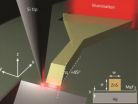Fracture prediction methods may be useful for patients with diabetes
2011-06-01
(Press-News.org) Use of established fracture prediction methods in older patients with type 2 diabetes mellitus (DM) found that scores from these methods were associated with hip and nonspine fracture risk, and a certain score associated with higher risk of fracture compared to persons without DM, according to a study in the June 1 issue of JAMA. Because patients with type 2 DM often have higher levels of bone mineral density (BMD), it has been uncertain the applicability of fracture risk screening methods typically used for patients with lower levels of BMD.
"It is increasingly recognized that adults with type 2 diabetes mellitus, an estimated 17 percent of older adults in the United States, have a higher fracture rate. Preventive identification of adults at higher fracture risk is based on bone mineral density T scores, used alone or in the World Health Organization Fracture Risk Algorithm (FRAX) score," according to background information in the article. "There is a need to clarify the use of standard methods for assessing fracture risk in this expanding population of older adults [with type 2 DM]."
Ann V. Schwartz, Ph.D., of the University of California, San Francisco and colleagues conducted a study to assess the associations of BMD T score and FRAX score with hip and nonspine fracture risk in older adults with type 2 DM. The researchers analyzed data from 3 prospective observational studies with fracture outcomes that included 9,449 women and 7,436 men.
Of 770 women with DM, 84 experienced a hip fracture and 262 a nonspine fracture during an average follow-up of 12.6 years. Of 1,199 men with DM, 32 experienced a hip fracture and 133 a nonspine fracture during an average follow-up of 7.5 years. The researchers found that femoral neck (segment of bone connecting the head of the femur and the shaft) BMD T score and FRAX score were associated with hip and nonspine fracture risk in patients with DM. "However, for a given T score and age, those adults with DM had a higher risk of fracture than those without DM, consistent with previous studies. Participants with DM also experienced higher fracture rates at a given FRAX score than participants without DM," the authors write.
"Our results indicate that femoral neck BMD and the FRAX score are as useful for the assessment of fracture risk in older adults with DM as in those without DM. However, interpretation of T score or FRAX score in an older patient with DM must take into account the higher fracture risk associated with DM," the researchers write. "Refinements are needed in current treatment and diagnostic algorithms for use in older patients with type 2 DM."
###
(JAMA. 2011;305[21]2184-2192. Available pre-embargo to the media at www.jamamedia.org)
Editor's Note: Please see the article for additional information, including other authors, author contributions and affiliations, financial disclosures, funding and support, etc.
To contact Ann V. Schwartz, Ph.D., call Jason Bardi at 415-502-4608 or email jason.bardi@ucsf.edu.
END
ELSE PRESS RELEASES FROM THIS DATE:
2011-06-01
Frequently cited studies involving associations of biomarkers report effect sizes that are often larger when compared to summary estimates from meta-analyses evaluating the same associations, according to a study in the June 1 issue of JAMA.
"Many new biomarkers are continuously proposed as potential determinants of disease risk, prognosis, or response to treatment. The plethora of statistically significant associations increases expectations for improvements in risk appraisal. However, many markers get evaluated only in 1 or a few studies. Among those evaluated more ...
2011-06-01
Despite concerns that surgeon fatigue is leading to dangerous complications for patients and data showing worse outcomes for many patients who undergo surgery at night, new Johns Hopkins research suggests that — in the case of heart and lung transplants — time of day has no affect on patient survival.
"We aren't suggesting that fatigue is good," says Ashish S. Shah, an assistant professor of surgery at the Johns Hopkins University School of Medicine and the study's lead author. "But what is important is that, at least in this specialty, it seems we're able to deal with ...
2011-06-01
A cloud-based environment offers convenient and cost-effective access to technology. However, it also increases the security risk and need for appropriate authentication and authorization processes--particularly as enterprise information extends from in-house systems to popular software-as-a-Service (SaaS) offerings, such Salesforce.com and Google Apps. A cloud-based approach to centralized identity management provides a robust alternative to server-based solutions for enabling secure access to diverse applications, whether on-premise or running as SaaS.
IT architects ...
2011-06-01
New research from the University of Leicester raises concerns about higher than expected mortality following acute coronary events such as heart attack in those with significant mental ill health.
Researchers from the University of Leicester in the UK and Curtin Health Innovation Research Institute in Australia examined 22 previous studies involving 825,754 individuals, comparing care given to those with and without serious mental disorders.
They discovered that there was higher than expected mortality following acute coronary events such as heart attack in those ...
2011-06-01
Since the Industrial Revolution, over half of all the CO2 produced by burning fossil fuels has been absorbed by the ocean, making pH drop faster than any time in the last 650,000 years and resulting in ocean acidification. Recent studies have shown that this causes fish to lose their sense of smell, but a new study published today in Biology Letters shows that fish hearing is also compromised.
Working with Professor Philip Munday at James Cook University, lead author Dr Steve Simpson of the School of Biological Sciences at the University of Bristol reared larvae straight ...
2011-06-01
Irvine, Calif. — Environmental and inherited risk factors associated with multiple sclerosis – previously poorly understood and not known to be connected – converge to alter a critical cellular function linked to the chronic neurologic disease, researchers with the UC Irvine Multiple Sclerosis Research Center have discovered.
The findings, which appear in the online, open-access journal Nature Communications, suggest that a unifying mechanism may be responsible for multiple sclerosis and point to therapies personalized according to genetic factors.
"MS results from ...
2011-06-01
Long-term relationships make the commonly abused drug amphetamine less appealing, according to a new animal study in the June 1 issue of The Journal of Neuroscience. The findings suggest that social bonds formed during adulthood lead to changes in the brain that may protect
against drug abuse.
Prairie voles are rodents that form lifelong bonds with mating partners. In the new study, researchers directed by Zuoxin Wang, PhD, of Florida State
University, found that male voles in established relationships displayed less interest ...
2011-06-01
STANFORD, Calif. — More than two dozen widely cited studies linking genes or other "biomarkers" to specific diseases vastly overstate the association, according to new research from an expert in scientific study design at the Stanford University School of Medicine. As a result, clinicians may be making decisions for their patients based on inaccurate conclusions not supported by other, larger studies.
The widely cited studies include one linking the BRCA1 mutation with colon cancer, another that links levels of C-reactive protein in the blood with cardiovascular disease ...
2011-06-01
The creation of a new quasiparticle called the "hybrid plasmon polariton" may throw open the doors to integrated photonic circuits and optical computing for the 21st century. Researchers with the U.S. Department of Energy (DOE)'s Lawrence Berkeley National Laboratory (Berkeley Lab) have demonstrated the first true nanoscale waveguides for next generation on-chip optical communication systems.
"We have directly demonstrated the nanoscale waveguiding of light at visible and near infrared frequencies in a metal-insulator-semiconductor device featuring low loss and broadband ...
2011-06-01
Two years ago, a widely publicized scientific report plucked an old mouse virus out of obscurity and held it up as a possible cause of Chronic Fatigue Syndrome. According to a new study published today by a group of researchers in California, Wisconsin and Illinois, that report was wrong.
The mouse virus is not the culprit in Chronic Fatigue Syndrome, said University of California, San Francisco Professor Jay A. Levy, MD, the senior author on the study, published this week by the journal Science.
"There is no evidence of this mouse virus in human blood," said Levy, ...
LAST 30 PRESS RELEASES:
[Press-News.org] Fracture prediction methods may be useful for patients with diabetes


